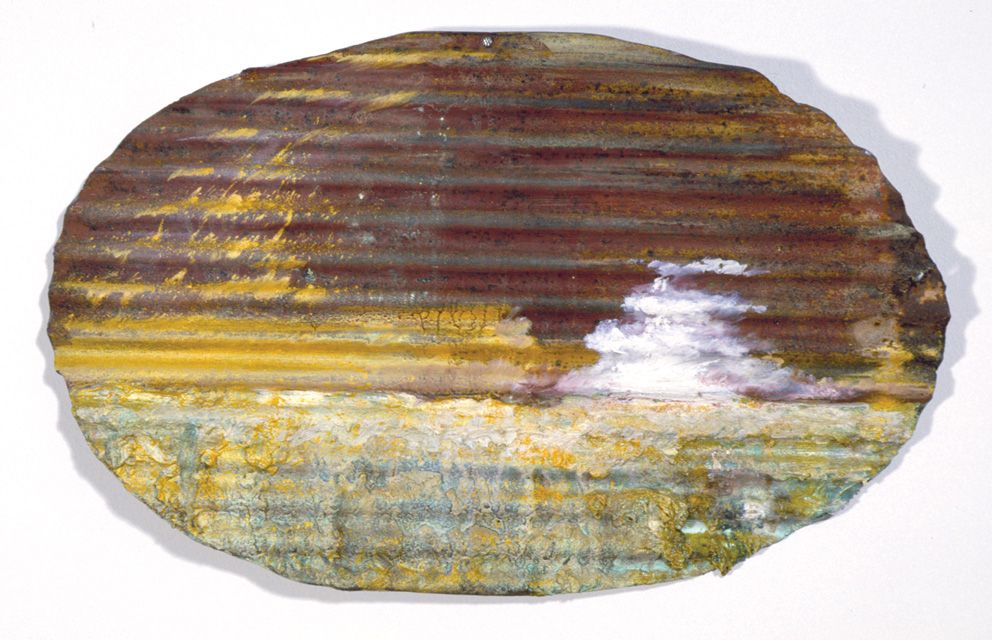


The painting of landscape was decidedly unfashionable during the early 1990s. While numerous artists pursued landscape as subject, the notion of romanticism—so often linked to the painting of landscape—was also decidedly out of favour. Art, it seemed in magazines and newspapers, had to be linked with popular culture, French theory and cool academia.
Similarly unfashionable during this period was the activity of plein air painting, but eschewing fashion—indeed, facing critical scepticism—Martin went bush. With a clear passion for the grandeur of the landscape and the seductive potential of the sublime, Mandy Martin has explored this realism since the 1970s. Working in the outback has made a physical impact on the work O-B-L-I-V-I-O-N (1993); the wind as much as the artist's hand has contributed to the end result, with black pigment spraying across the sky in an apocalyptic dust storm.
Martin believes that the tradition of European landscape painting can be tinkered with, adapted and reinvigorated in response to local context. Indeed, recognising the historical and political significance of landscape imagery in Australia, Martin commented that 'the exoticism of death lured nineteenth-century explorers into a sublime engagement with the landscape. Their narratives are now a metaphor for the struggle non-aboriginal Australians have finding some other spiritual relationship with that same landscape'.1
But in a move that places the artist firmly in the twentieth-century, Martin utilises text in O-B-L-I-V-I-O-N, an element that her nineteenth-century predecessors would have recoiled from. Thus, O-B-L-I-V-I-O-N straddles the stylistic tropes of both centuries. The title of this painting refers to a nineteenth-century work by the British painter John Martin, Sadak in search of the waters of oblivion (1812), which 'epitomises the fascination of the period for apocalyptic visions of despair and destruction set within desolate and remote landscapes'.2
O-B-L-I-V-I-O-N addresses a number of contemporary social, environmental and cultural issues. The environment had become a pressing topic, with issues ranging from salination to uranium mining hitting the headlines. While Martin would obviously have consumed these elements, her work also suggests a strong awareness of the history of colonial responses to the Australian outback, which were often apocalyptic in nature.
It is the remoteness of the Australian bush that leads to the creation of a variety of surreal objects in the outback, from crow traps to corrugated-iron dog sheds. Created out of necessity and responding to the environment, they litter the outback, rusting into the earth. It is these strange structures that Martin must have had in mind in the creation of the small work D-Y-I-N-G (1994) which is painted with oil on corrugated tin. The material is distinctly Australian due to its ubiquitous usage in both suburbia and the countryside as a generic material for shelter. Martin has built up the surface of this painting to suggest the colouration and texture of the desert. Like much nineteenth-century art, Mandy Martin opts for a dark palette of browns, blacks and greys which emphasise the sense of the remote. The title, D-Y-I-N-G, could refer to the necessity of such materials for shelter in the harshness of the bush or, simultaneously, the sense of decay and corrosion that man-made objects in the desert take on. Eventually, nature consumes all.
The inherent melancholia of these works sit in the tradition of the harsh desert paintings of Nolan, Drysdale, and Tucker, where the landscape takes on a surreal harshness far removed from the colonial attempts to civilise the land on canvas. The issues raised in Martin's desert works were perhaps best articulated by the philosopher, Arthur Schopenhauer, when he discusses the response to a transition between a lush, verdant landscape and that of the desert:
Now let us imagine such a region denuded of plants and showing only bare rocks; the will is at once filled with alarm through the total absence of that which is organic and necessary for our subsistence. The desert takes on a fearful character; our mood becomes more tragic. The exaltation to pure knowledge comes about with a more decided emancipation from the interest of the will, and by our persisting in the state of pure knowledge, the feeling of the sublime distinctly appears.3
Reading Martin's journals and perusing her paintings, it becomes clear that the despair suggested comes from being a first-hand witness to the degradation of the landscape via the imposition of the white man on the land. Eden has been trampled by cattle.
- Ashley Crawford
Mandy Martin is represented in Australia by Australian Galleries, Melbourne and Sydney.